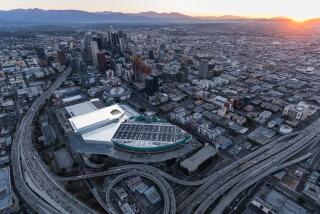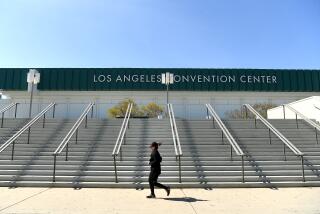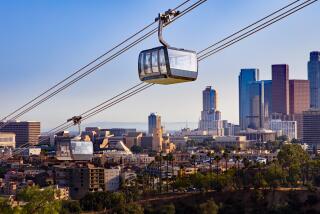Thorny Dilemma on Convention Center : Rebids Could Save $10 Million but Delay Might Cost City More in Lost Business
Nearly $10 million could be saved by rebidding San Diego’s waterfront convention center, but the resulting delay in construction could cause the loss of that much--or more--in convention business, a special mayoral task force was told Wednesday.
Those financial scenarios emerge from reports from two subcommittees that presented the task force with diametrically opposed recommendations--one urging that the convention center be built immediately despite a projected $20-million-plus cost increase, while the other panel proposed that the project be rebid in an attempt to reduce construction costs.
“It looks like it came down to the left side of the table versus the right side of the table,” joked acting Mayor Ed Struiksma, noting that proponents of the divergent recommendations were, for the most part, seated across from one another during a nearly two-hour City Hall meeting.
With the San Diego Unified Port District facing a May 18 deadline on whether to award a construction contract to one of the six firms that bid on the project last month, Struiksma said Wednesday that he expects the task force to issue its recommendation next week. Struiksma established the task force after construction bids came in last month more than $22 million over budget.
Wednesday’s reports appear to present the task force with a thorny dilemma that involves weighing potential construction savings at the front end of the project against the later loss of convention business likely to result from a delay in the opening date. In short, the financial equation facing the task force might be described thus: You can save money now, but, in doing so, you might lose at least that much later.
Further complicating that decision is the fact that the two key sets of funds being scrutinized--construction expenses versus convention dollars--carry with them considerably different stakes for the port and the city.
The port, which will fund construction of the 1.4-million-square-foot structure, is most concerned with the building costs and, conceivably, might regard a minor construction delay as an acceptable trade-off for a potential $10-million savings. The city, on the other hand, expects to derive millions of dollars annually in new tax revenues from business generated by the convention center and, therefore, would lose money if the late-1988 target opening date is postponed.
“These are very different kinds of dollars,” port Commissioner William Rick conceded. “For one thing, they’re coming out of different pockets. And what you save here might cost you there. There are a lot of factors to consider.”
The financial analyses debated Wednesday shifted the task force’s focus from why the project’s estimated cost has grown so substantially to, as Struiksma put it, “where we go from here” in the wake of the higher-than-expected construction bids.
The six base bids received last month ranged from $123.9 million to $133.7 million--more than 20% above the port’s $101.5-million budget for construction of the Navy Field structure. Excavation, utilities, furnishings and other costs could push the center’s final cost to nearly $160 million--$65 million more than the $95-million price tag often cited by proponents in the November, 1983, campaign in which San Diegans approved the project in an advisory vote.
Last week, Struiksma divided the task force into three subcommittees and assigned each to review different facets of the controversial project.
One panel, instructed to determine whether the port had sufficient revenues to cover the higher costs without jeopardizing other projects, answered that question affirmatively Wednesday. Lee Grissom, president of the San Diego Chamber of Commerce, pointed out that, even if the port were to proceed with the convention center at the current projected cost, the port could continue to annually finance $20 million worth of other planned programs and still would have a $52-million cash balance when the center’s construction was completed.
Another subcommittee studied whether construction costs could be cut without a lengthy delay in the project’s timetable, while the third group reviewed potential revenue to be raised by the convention center and the possible impact of any delays.
Architect Paul Buss, chairman of the group that analyzed the construction costs, told the task force that rebidding the project, coupled with minor design changes, could cut costs by “$10 million to $15 million maximum, and I wouldn’t hope for the $15 million.”
That approach could cause about a four-month delay, Buss acknowledged. However, because excavation of the site, a process already six months behind schedule due to water drainage problems, is not expected to be completed until mid-June, the practical delay could be only about two months, the architect noted.
A major reason for the projected savings, Buss pointed out, is that a second round of bidding would occur in a “considerably less-chaotic atmosphere.” Because of numerous design changes that occurred during the final stages of last month’s bid process, the firms that bid may have inflated their figures as a safeguard against unexpected expenses or construction problems stemming from those changes, the subcommittee report said.
Noting that there would be less “uncertainty” in a rebid process because the design plans are now nearly complete, the report added, “The elimination of this ‘scare’ factor might produce a significantly lower bid.” That theory is in accordance with convention center architect Ward Deems’ finding that the bidding contractors’ projected overhead and profit figures were about $5.8 million higher than expected.
Costs could also be reduced, the panel reported, through minor design changes--primarily, a simplification of the large concrete “fins” that are major architectural and structural elements of the convention center’s design. Construction of the nearly 100-foot-tall fins, visible from the building’s exterior, is “extremely complex and, therefore, costly,” the report said, adding that fabrication simplifications “could save significant dollars.”
Another cost-cutting plan suggested in the report involves lengthening the proposed construction timetable from the present 26 months to 30 months, which would reduce the need for labor overtime expenses, for example. If a second round of bids are sought, the panel said bidders should be asked to prepare alternate 26-month and 30-month cost figures.
However, one undesirable byproduct of a longer construction period would be an additional four-month delay in the convention center’s opening date. Indeed, the other subcommittee warned Wednesday that any potential construction savings could be offset by the loss of convention business likely to result from any delay in the center’s opening.
Jim Granby, president of the convention center’s board of directors, emphasized that some of the nearly $25 million in convention business already booked for the facility’s first year “would be in serious jeopardy” if the current projected August, 1988, opening is pushed back. Any delays also could cause “a major credibility problem for San Diego” among national convention booking agents, resulting in possible long-range harm, he added.
“However unpleasant . . . the higher costs are, we think it’s important to proceed now,” Granby said.
Jim Durbin, head of the San Diego Hotel-Motel Assn., conceded that the potential two-month rebid delay “wouldn’t have that significant an impact.” However, Durbin and others said they were skeptical that the delay would be as short as Buss’ projection.
“Once you delay, these things tend to stretch out,” Durbin said. “If that happens, you’ve got major problems.”
The subcommittee chaired by Granby noted in its report that the convention center is expected to generate more than $190 million in annual visitor spending. The city is expected to receive nearly $10 million in annual tax revenues from the project, and, by 1991, is projected to more than double its current $19-million annual hotel-tax receipts, the report said.
“That’s what we’re risking if we delay this thing again,” Granby concluded.
More to Read
Sign up for Essential California
The most important California stories and recommendations in your inbox every morning.
You may occasionally receive promotional content from the Los Angeles Times.










